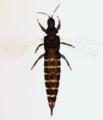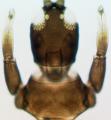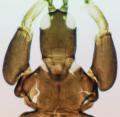Haplothrips leucanthemi
Recognition data
Distinguishing features
Both sexes fully winged. Body brown to dark brown, fore tarsi and base of antennal segment III yellow; fore wing pale with base extensively shaded. Head slightly longer than wide; maxillary stylets one third of head width apart, retracted to postocular setae, maxillary bridge complete; postocular setae acute, usually not reaching posterior margin of compound eyes. Antennae 8-segmented, segment III with 2 sensoria, IV with 4 sensoria; VIII short and broad at base. Pronotal setae small and acute, anteromarginal and midlateral setae no longer than discal setae; epimeral sutures complete; prosternal basantra and ferna present, mesopresternum eroded to paired lateral triangles. Fore tarsal tooth minute in female, large in large male. Fore wing constricted medially, with 7–12 duplicated cilia, sub-basal setae acute or blunt. Tergite IX setae S1 bluntly pointed, much shorter than tube, S2 acute.
Male with no pore plate on sternite VIII; tergite IX setae S2 short and stout; pseudovirga of aedeagus slender.
Related and similar species
The identity of H. leucanthemi is a problem that merits further study. This species is particularly associated with large daisy flowers, such as those of Chrysanthemum leucanthemum. However, there is a form in red clover flowers, Trifolium pratense, that is commonly known as H. niger, but this is considered to be a parthenogenetic strain of H. leucanthemi. Within the genus this thrips is remarkable because of the unusually short setae on the head and pronotum (Mound & Minaei, 2007). The genus Haplothrips, one of the three most species rich genera of Thysanoptera, currently includes about 245 species worldwide (Mound & Minaei, 2007), these being found mainly from Europe across the Old World. No member of the genus is known to be endemic to the Neotropics, although a few species come from southern South America (Mound & Zapater, 2003). Only 17 species are listed from Mexico and North America (Mound & Marullo, 1996), with six of these recorded from California (Hoddle et al. 2004). Little is known of the biology of the Californian species, although elsewhere the species of Haplothrips are associated particularly with the flowers of Poaceae and Asteraceae.
Taxonomic data
Current valid name
Haplothrips leucanthemi (Schrank)
Original name and synonyms
- Thrips leucanthemi Schrank, 1781: 298
- Phloeothripsniger Osborn, 1883: 154
- Phloeothrips armatus Lindeman, 1887: 335
- Phloeothrips obscuricornis Reuter, 1909: 20
- Haplothrips trifolii Priesner, 1919: 130
- Zygothrips wyomingensis Watson, 1923: 82
Family placement
Phlaeothripidae, Phlaeothripinae
Biological data
Life history
Breeding and pupating within flowers
Host plants
Various Asteraceae, also Trifolium sp. (Fabaceae) and Plantago sp. (Plantaginaceae)
Tospoviruses vectored
None
Crop damage
None
Distribution data
Area of origin
Presumably Northern Europe
Distribution
Cott (1956: 111) lists this species, under the name H. niger, as widespread across the northern parts of North America into California. It is also widespread across Europe to Iran, and is known from New Zealand and southern Australia, with a few records from Chile and Argentina.






